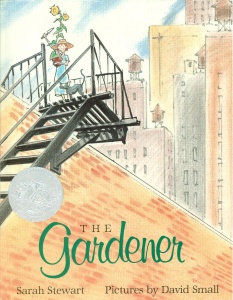National Children’s Book Week 2
Listen to the Recess! Clip
| Author | John Cech |
| Air Date | 11/16/1999 |

National Children’s Book Week Transcript
On the second day of National Children’s Book Week, we’re harvesting a wonderful crop of picture books that follow the week’s theme: “Plant a Seed …. Read.” In the most literal of ways, that’s what the writer Sarah Stewart and the artist David Small are doing in their recent Caldecott Honor Book, The Gardener. It’s the story of a girl, Lydia Grace, who is sent away from the family farm by her parents to live with her unsmiling Uncle Jim in the city, to help him out at his bakery. The book is set during the Depression of the 1930s, and is told in the form of letters that Lydia Grace writes home. She may have been taken out of the country, but you can’t wash away her green thumb, and soon she has planted seeds in every nook and cranny she can find around the shop, turning the grimness of her experience into radiant blooms of promise and hope that even transform glum Uncle Jim.
Sector 7 by David Wiesner has taken the Book Week theme into the stratosphere, seeding the clouds. This is a breathtaking fantasy about a boy who’s transported from the top of The Empire State Building where he’s gone on a school field trip, to a celestial factor y where clouds are produced, in all the familiar shapes and sizes. But the clouds are tired of the old blueprints, bored with being just another cumulus or cirrostratus. With the boy’s creative help they outfit themselves in new shapes — as exotic tropical fish and other deep sea creatures. Wait until you see the sky above Manhattan when it’s under the sea.
But perhaps the most intriguing of all these book-plantings is Westlandia by Paul Fleischman, illustrated by Kevin Hawkes. It’s about a kid named Wesley who gets picked on because “he alone in his town disliked pizza and soda . . . found professional football stupid . . . [and]refused to shave half his head, the hair style worn by all the other boys, despite his father’s bribe of five dollars.” Instead for his summer project, he decides to found his own civilization in suburbia “based on a staple food crop.” His crop is a strange fruit that tastes like “an entrancing blend of peach, strawberry, pumpkin pie and flavors he had no name for” and the plant gives him food, shelter, clothing, paper, ink, as well as bug lotion and sun screen. It’s a wonderful premise, with a remarkable mythic quality that says that it is possible to grow anything if you have the right seeds, and you know where to dig.